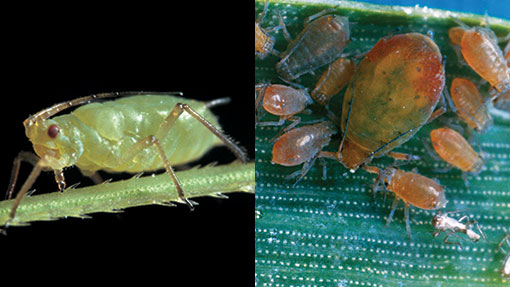Identify and treat aphid threat in new cereal crops

An unusually mild September is pushing up the threat from virus-carrying aphids and growers should monitor cereal crops as they emerge and treat where the pest is present.
The latest aphid bulletin compiled from Rothamsted Research’s nationwide network of suction traps shows various species of aphids are mobile across the country, but in relatively low numbers.
Among them is the bird-cherry aphid (pictured, right) that, along with the grain aphid (pictured, left) is the main vector of barley yellow dwarf virus (BYDV), a disease that affects all cereal crops and can cause up to 50% yield loss.
Despite low numbers, growers shouldn’t be complacent and the institute’s aphid expert Richard Harrington says the pest could still be colonising crops.
Hutchinsons’ top BYDV-busting tips
- Monitor Rothamsted aphid alerts
- Non-Deter-treated early-drilled crops should be sprayed from one leaf, but monitor at emergence for aphid numbers
- Treat appropriate to risk and conditions
- Applications will be required until seasonal risk has passed
- Be realistic with pyrethroid dose and expectation of persistence
- Identify aphid species present and consider adding the adjuvant Wetcit to a full dose of pyrethroid if grain aphids are detected
- Check product label for number of applications or total dose in crop
- Ensure that anthropod buffer zones are observed
- Do not overreact with blanket multiple treatments – this will deplete the natural predatory population
“At current numbers the risk of virus spread would usually be very low, but with the warm weather, once a winged aphid lands in a crop, conditions are ideal for reproduction, so they can multiply and begin moving through the crop very quickly,” he explains.
It is the second-generation offspring that Dr Harrington identifies as critical and growers should aim to control the aphids before those carrying BYDV can spread the disease through the crop.
“Growers that have treated their seed with an insecticide dressing won’t need to worry for the time being, but where crops are untreated, monitoring will be required,” he adds
Identify species
David Ellerton, technical director at distributor Hutchinsons, says there is already early-sown wheat in the ground unprotected by a seed treatment, which is a concern in the current mild conditions.
In these cases, Dr Ellerton urges growers to keep an eye on crops and identification between the two virus vectors – the bird-cherry and grain aphid – will be crucial to control strategy.
“According to testing by Rothamsted, about 50% of grain aphids are resistant to pyrethroids across eastern England,” he says.
“Pyrethroids are still effective against bird-cherry aphids, but control of grain aphids could be compromised and there are currently no alternative modes of action available,” adds Dr Ellerton.
Hutchinsons have investigated the use of Wetcit – an orange oil-based adjuvant that has been helping growers in the USA control pesticide-resistant peach potato aphids.
Dr Ellerton says if the grain aphid is the target, adding the product to the tank mix with a pyrethroid could help control where resistant aphids are present.
“It coats the aphid and as it dries, the aphid also dries and dies. It’s a physical effect, so isn’t affected by the resistance. Maintaining full pyrethroid dose rates is also vital,” he explains.
Buffer for beneficials
Dr Ellerton reminds growers that pyrethroids can harm beneficial insects that feed on aphids, so a buffer zone should be applied and spray drift minimised.
“Sprayer operators are aiming to cover an upright, thin-leaved target where a fine-medium quality spray is ideal.
“Droplets produced in the ‘fine’ category are prone to drift and should be minimised wherever possible. Angled nozzles improve coverage to an upright cereal leaf, allowing for a less drift-prone medium quality spray choice.”
Minimising the threat from BYDV vector aphids will reduce the need to make foliar treatments and removing any “green bridge” such as volunteers in stubbles with a glyphosate treatment will help, adds Dr Ellerton.
“Cultivations alone will only serve to bury aphids with a food source where they can survive and return to the surface and pose a threat.”

